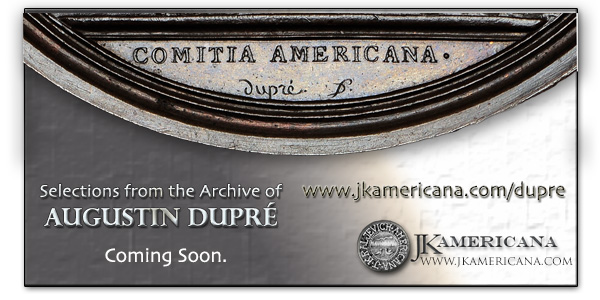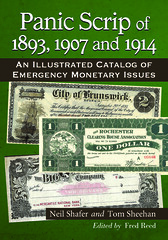
PREV ARTICLE
NEXT ARTICLE
FULL ISSUE
PREV FULL ISSUE
BOOK REVIEW: PANIC SCRIP OF 1893, 1907 AND 1914
John and Nancy Wilson submitted this review of the new book on Panic Scrip by Neil Shafer and Tom Sheehan. Thanks!
-Editor
The long-awaited new book on Panic Scrip of 1893, 1907 and 1914 is here at last. Never had anyone covered these three periods of the panic in such an authoritative and comprehensive manner. Like many others, we provided dozens of photos of panic scrip notes from our collection. This new Panic Scrip book is soft cover (7 X 10), with 416 pages and 808 black and white illustrations. The illustrations are shown at 60 percent to 90 percent of original size; each is marked as to the precise percentage. The acknowledgments contain about 70 individuals along with the ANA, ANS, Eric P. Newman Numismatic Education Society and Smithsonian Institution. The authors obtained some funding from the Central States Numismatic Society, Milwaukee Numismatic Society, Numismatists of Wisconsin, South Shore Coin Club and the Society of Paper Money Collectors. The Preface discusses the economic downturns that caused panic scrip notes to come into existence. Sources of notes and information came from great collectors such as Maurice Burgett, Chester Krause and Herb and Martha Schingoethe and several institutions named in the book. The authors were greatly helped by Douglas Corrigan who provided a compilation and census of 1907 scrip notes. How to Use This Book explains the new cataloging system used in the book. The types of notes listed in this reference are 1. Clearing House Loan Certificates. 2. Clearing House Certificates. 3. Clearing House Checks. 4. Cashier’s Checks. 5. Payroll Checks. Also covered are issues that aren’t included; note descriptions; general characteristics and the states of existence (designations by each note let you know if it is issued, unissued, sample, specimen, and proof, unreported or other factor). The rarity of these notes is explained along with rarity ratings and values. As an example of how rare these issues are, the Milwaukee Clearing House Certificates are mostly all R5 (highest rarity) with only one to five known of each. Part 1. Scrip from the Panic of 1893. The book explains the causes of this panic, such as the drop in commodities and crops; the Sherman Silver Purchase Ace of 1890; railroad failures and bank failures; the stock market collapse; problems after President Grover Cleveland was sworn into office and other economic upheavals of that time. The recovery from this panic started with the election of President McKinley in 1896. Part ll. Scrip from the Panic of 1907. History of the “Rich Man’s Panic,” gives you insights on how this panic evolved from the early 1900s to the actual panic itself in 1907. Much of the information is excerpted from this book. From the good years of President McKinley and his slogan, “The Full Dinner Pail,” to the administration of President Roosevelt and the start of this panic, the authors give you the reasoning and logic for the Panic of 1907. “Heinze and the Development of the Panic,” explains how he and C. F. Morse were relatively newcomers to Wall Street and yet, they did have a reputation as fast wheelers and dealers. Heinze, who was a copper speculator, became involved in banking as a President of the Mercantile National Bank. Because of his involvement as a speculator, many depositors removed their funds from this bank. Charles Barney, President of the Knickerbocker Trust, had a good relationship with Heinze. Because of that relationship, it caused the National Bank of Commerce to refuse to clear for the Knickerbocker. Though Barney resigned, fear spread among its 18,000 depositors and in short order there was a run on the firm and it was forced to close its doors. This action occurred October 21, 1907, and the panic of 1907 had begun. Unfounded fear rapidly spread across the country and runs on banks started in large and small cities in the country. Bank Holidays were declared by Governors in some states and emergency notes soon appeared in various forms and from several different entities. In several months, it is estimated that nearly 500 million in currency substitutes circulated during this period. In reflecting back on Heinze, it is hard to believe that he probably was the person most instrumental in starting the Panic of 1907. “Intercession of J. Pierpont Morgan,” Mr. Morgan was very instrumental in bringing it to an end. While watching all the events, he was content to let the Knickerbocker bank fail, but he knew that the panic had to be stopped. With his great wealth and connections with the President, Wall Street executives, banking and brokerage officials and the Treasury Secretary George Cortelyou, he started the wheels in motion to place money into circulation. By acting as a virtual one-man federal reserve bank, Morgan literally saved the day. By February, 1908, the panic was brought to an end. “Aftermath of the Panic.” In 1908 the Aldrich-Vreeland Currency Act was passed which commissioned many changes in the banking system. After extensive changes a Virginia Democrat, Carter Glass, proposed the Federal Reserve Act in 1913. President Wilson saw to it that the bill was pushed through Congress and the Federal Reserve Bank System was born. This system provided the needed elasticity. We can remember in the early 1990s at a Milwaukee convention. A local dealer was able to obtain three Milwaukee Clearing House Scrip 1907 notes from a local retired banker. The dealer asked us what they were worth. We quickly went to Neil Shafer and asked him. He said $25 or $30 each. The Wilson, Bertschy and Shafer collections each got a note that wasn’t readily available in the marketplace. When Dean Oakes (Hickman & Oakes) auctioned off the Bertschy collection, we were able to pick up a few more of these Milwaukee Clearing House scrip notes. Part lll. Scrip From The Financial Crisis of 1914. The crisis at the outbreak of World War 1 caused gold to quickly disappear which imperiled America’s ability to repay its debts abroad. Fear quickly spread worldwide that the U. S. would “abandon the gold standard.” The dollar plummeted on world markets. The New York Stock Exchange was shut down by William Gibbs McAdoo for four months, “to prevent Europeans from selling their American securities and demanding gold in return.” McAdoo brought about a “great deal of emergency currency” as he didn’t want to see a repeat of the Panic of 1907. Because of McAdoo’s intervention the authors say that, “All these fiscal achievements removed most of the need for local scrip, accounting for the very few issues found in this section of the catalog.” The Federal Reserve came into existence as the 1914 crisis waned. McAdoo “served as the first chairman of the Federal Reserve Board. Appendix A. 1907 Pseudo or Parody Scrip. This section contains scrip that resembles the 1907 panic scrip. Resembling currency the makers of these notes were hopeful the public would pick them and then read the advertising messages that were on them. The three pages contain only eight pieces and five of them are R5. Appendix B. Miscellaneous Scrip. The authors used auctions, collectors and their collections, along with many other sources that provided notes for this project. The 12 pages of scrip contained in this section are pieces that didn’t fit into the 1893, 1907 or 1914 chapters. Instead of not using them at all, the authors placed these notes into this section which they call the “lost” notes. Appendix C. The Clearing House Certificate as a Cash Substitute, 1857-1933. Professor Loren Gatch, the author, explains all the reasons that Clearing House Scrip came into existence. Over the years many books and articles have covered economic conditions between 1857 and 1933. Now, in only 15 pages, Professor Gatch covers these economic conditions in an interesting and easy to read manner. Clearing House Loan Certificates are explained between the periods of 1860 to 1884. The three different periods in this book are covered. The period of 1933 is even covered. Were Clearing House Certificates and Other Emergency Monies Legal? You will see the court rulings and other laws that made this emergency money legal. The importance of the Aldrich-Vreeland Notes of 1914 is also covered. The conclusion of this article explains in only three paragraphs the rise and fall of clearing house certificates. Appendix D. G. G. B. DeBernardi Labor Exchange Scrip of 1895-1905. Authored by Steven K. Whitfield. In 2009 our good friend Steven Whitfield authored a book on Kansas Paper Money, An Illustrated History, 1854-1935, which contained a few pages of information on DeBernardi scrip issues. That information is in this new book. The Bibliography and Index close out this reference. This is important information for researchers and collectors. What an excellent book and source of information for these rare Panic Scrip of 1893, 1907 and 1914 notes. The many years of research by the authors finally came to fruition with the publication of this important reference. A subject “NEVER BEFORE COVERED,” we consider this a must buy for all numismatists. We thank Neil and Tom, along with the other contributors for writing this important reference. For information on purchasing this book, it is available for $75 from the publishers: McFarland & Co. Inc., Box 611, Jefferson, North Carolina 28640, Phone No. (800) 253-2187, www.mcfarlandpub.com or Email info@mcfarlandpub.com

Wayne Homren, Editor The Numismatic Bibliomania Society is a non-profit organization promoting numismatic literature. See our web site at coinbooks.org. To submit items for publication in The E-Sylum, write to the Editor at this address: whomren@gmail.com To subscribe go to: https://my.binhost.com/lists/listinfo/esylum All Rights Reserved. NBS Home Page Contact the NBS webmaster 
|
